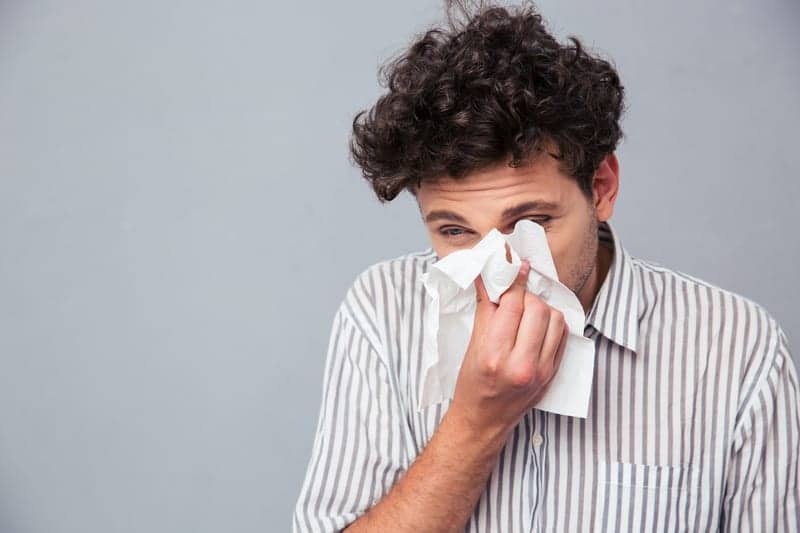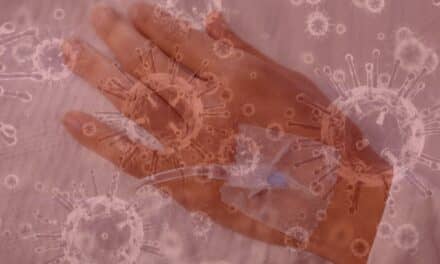A study links potential NAR with worse sleep and distress symptoms. Treating NAR with azelastine-based drugs may also help NAR-sufferers better adhere to PAP therapy for sleep-disordered breathing.
Nonallergic rhinitis (NAR) is a common condition that involves symptoms that resemble an allergy (such as nasal congestion and stuffiness) but that do not have an allergic trigger. Though only minimal research has addressed NAR and sleep, a study published in the journal Sleep Breathing Physiology and Disorders suggests that more research should be done on NAR and sleep disorders to improve patient outcomes. The study evaluated the frequency of potential NAR symptoms in a large sample of sleep center patients.
Study Details and Results
Study first author Barry Krakow, MD, says a classic sign of NAR is that antihistamine pills and nasal steroid sprays (standard allergy treatments) do not provide symptom relief. That caused Krakow and coauthors to ask themselves: “Why are there so many people being treated by their primary care doctors with antihistamines, decongestants, and nasal steroids, and yet, patients are saying they’re not getting better?” Krakow explains. “The paper itself, which was prompted by this experience, was trying to figure out what exactly are the symptoms that our patients are suffering from.”
A retrospective chart review was conducted on 2,658 adults patients at Krakow’s sleep center, Maimonides Sleep Arts & Sciences in Albuquerque, from 2008 to 2012, and a total of 1,703 patients reported clinically relevant nasal congestion. Potential NAR status was determined using a brief survey. In addition, patients diagnosed with sleep-disordered breathing (SDB) were analyzed by NAR status. The results of the study revealed that 70% of patients with congestion had potential NAR, and these patients showed notably higher congestion scores than those who did not have NAR.
“It started out with 1,700 people and 70% of those had congestion scores suggesting a potential problem with NAR,” Krakow says. “That’s a very high proportion of patients at a sleep center and it makes us wonder whether other sleep professionals are paying attention to this condition or how to ask questions to screen for it?”
Indeed, regardless of presenting chief complaint and ultimate diagnosis of SDB, possible NAR was common in patients at the center at a rate potentially greater than twice that reported in the general population. Also, potential NAR was linked to worse sleep and distress symptoms, such as anxiety and depression
Treatment and Diagnosis
Sleep medicine professionals have the opportunity to help diagnose NAR during the patient intake process. Two key questions can help diagnose the condition, Krakow says. First, ask patients about nonallergic triggers such as changes in the weather, wind, or temperature adversely affecting their nasal congestion. Second, ask what kind of response the patient is having to his/her current congestion treatment. Krakow says, “If the current response is mediocre, that itself suggests the problem may not be solely allergic rhinitis. Maybe it’s a case of NAR or both allergic rhinitis and NAR, which could explain why certain medicines are not working.”
Prior to starting PAP therapy for SDB, treating the nasal congestion related to NAR with nasal sprays can be an effective first-line therapy, Krakow says, noting that PAP therapy may aggravate the sinuses and worsen nasal congestion. When patients at his practice present with nasal congestion, Krakow does not immediately prescribe PAP if NAR is suspected. Instead, the staff advises patients to use one of several nasal sprays. Krakow’s team gives patients this explanation: “’We want to treat your nasal congestion first with Astelin, Astepro, or Dymista. Then, we will reevaluate. If things have gotten better, then we’ll start you on a PAP machine.” This approach has been successful and satisfying, Krakow says. He estimates that 70% to 80% of patients in his practice say one of these sprays are the best treatment they have ever used for their congestion, which previously had almost always been assumed to be allergic rhinitis.
The azelastine-based drugs have also made a “huge difference in people who were previously trying to use PAP therapy, [which can] actually cause the NAR response as a form of wind blowing in the nasal airway,” Krakow says.
The research also found that depression and anxiety symptoms were worse in patients with NAR. Krakow says, “I think this observation is interesting, but it may only indicate that anybody who has congestion in their nose for any reason can have a worsening of various symptoms. Still, we should take seriously the fact that a congested patient is typically suffering worse than an uncongested patient.”
Clinical Implications and Future Research
To further examine the connection between NAR and sleep disorders, Krakow suggests both basic level and advanced research be conducted. On a basic level, Krakow says what is needed is to test what kinds of changes a clinician can foster in a patient’s sleep by aggressively treating NAR. For more advanced studies, Krakow suggests exploring the impact of various treatments, such as the use of appropriate nasal sprays in patients initiating therapy for SDB with either an oral appliance or a PAP device. Randomized control trials could discern whether the addition of an azelastine nasal spray or combinations of antihistamine and steroid nasal sprays impact early adherence and outcomes.
“These kinds of studies would be quite valuable because we would learn whether or not aggressively treating the source of congestion makes it easier for people to use PAP, make their response to PAP better, or makes the patient use the PAP more hours during the night. The same would hold for OAT. This research could prove highly relevant to clinical management decision-making.”
Overall, Krakow suggests physicians attempt to treat symptoms of NAR with medication before prescribing PAP. Krakow says, “What if it turns out that there’s a lot of people out there with NAR coming to sleep centers, and what if they started on an antihistamine nasal spray, such as Astelin, Astepro, or Dymista as well as other brands…and then respond, ‘You know what, I’m already sleeping better.’ That’s such a great thing when you can do little things to move someone’s sleep in the right direction. We’ve done that, and it’s been successful.”
The clinical implications may be in identifying sleep patients with NAR and properly treating the condition. “I think we potentially identified a very large gap in the way clinical care would be delivered in a sleep center if a center is not specifically looking for NAR,” says Krakow. “I have a feeling that this is opening up a huge opportunity to recognize that many more patients at sleep centers have the problem of NAR, and therefore, it needs more attention. In turn, treating NAR may help patients to be able to use their PAP masks and improve their sleep in timely fashion.”
Cassandra Perez is associate editor for Sleep Review. CONTACT [email protected]






Cassandra,
Hi, my name is James Haluska and I am 42 year make with NAR and mild sleep apnea. I live in NYC and would like to know where I can find help for my condition.
Thanks,
James Haluska
I think the link is simply being tired.
I believe I am allergic to being tired.
If I wake in the night, or have gone to sleep late and woke early my rhinitis starts. The same goes for both my adult sons and adult granddaughter. I hope that there will be more research on this connection
I have chronic non allergenic rhinitis & find I cannot use my CPAP, which was prescribed a few,months,ago. Are there any specialists,in Nebraska,that can help me with my condition???